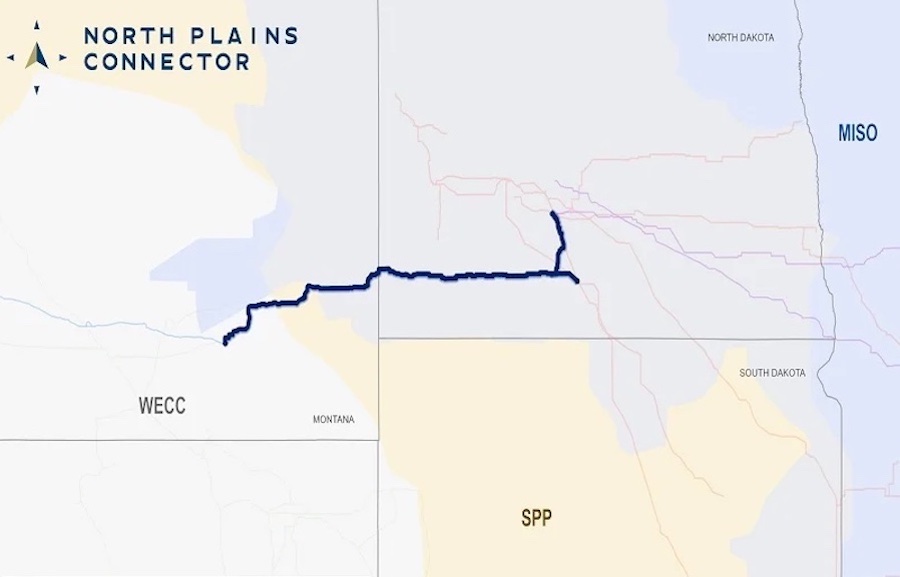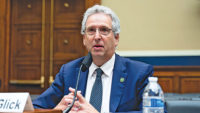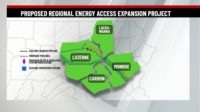Backers of the $2.5-billion North Plains Connector say they aim to begin permit approval this year for a 385-mile, high-voltage direct-current transmission line that could be first in the U.S. to link three large regional power grids—Western Interconnection, Midcontinent Independent System Operator and Southwest Power Pool—allowing shared energy from multiple sources and boosted system reliability.
Independent developer Grid United says the transmission line would extend from central North Dakota to southeastern Montana and would carry up to 3,000 MW between the three power markets—also known as WECC, MISO and SPP, respectively (see map above).
The Houston firm announced a memo of understanding with Allete, a Duluth, Minn., energy company that owns electric utilities in Wisconsin and Minnesota. The firms said they plan to execute a development agreement for the line by midyear, with a tentative in-service date of 2029.
“This innovative project is an important step toward a resilient and reliable energy grid across a wide area of the country,” said Bethany Owen, Allete chair and CEO, in a statement. The firm would own at least 35% of the project and operate it.
Grid United CEO Michael Skelly said the firm also is developing five other HVDC lines from 100 miles to 300 miles long in western states. Its advisory board includes Jack Hand, former CEO of Power Engineers.
Inter-grid collaboration is “critically important,” Southwest Power Pool official David Kelley said.
In a recent study, however, the U.S. Energy Dept.'s National Renewable Energy Laboratory found that “stitching together” U.S. transmission regional systems could help harness more renewable energy sources, balance power loads and reduce operating costs.
Its research shows that seven existing high-voltage links allow only 1,320 MW to move between regions of heavier power use and those where more renewable energy is being built. The independent Electric Reliability Council of Texas (ERCOT) also has minimal power-sharing capacity with regional transmission operators, the study said.
That has proved problematic during recent weather-generated system outages, Michael Goggin, vice president of consultant Grid Strategies LLC, said on a Feb. 8 webinar held by the American Council on Renewable Energy (ACORE). He authored a new report for the group highlighting the Texas power shortfalls.
“Making the grid bigger than the weather is the key to making our power system more resilient,” Goggin said. “A stronger transmission network could have kept the heat on for hundreds of thousands of Americans who lost power."
Goggin said the Federal Energy Regulatory Commission has authorized construction of a high-voltage, direct-current line from the ERCOT service territory to that of the Tennessee Valley Authority, with multiple proposals pending.
High-Voltage, Low Total
But only 552 miles of high-voltage transmission was added in the U.S. in the first 11 months of 2022, less than half that of the previous year and nearly three-quarters comprised of 230kV line, generally below what is needed for long distance power transfer, said a new FERC report.
That total also is far below what is needed in the U.S. to reach the Biden goal of carbon-free power by 2035, with as much as 1 terrawatt (TW) of generation and 420 GW of storage capacity, most zero carbon, lacking interconnection.
The report estimates that developers aim to have 6,335 miles of proposed projects in service between December 2022 and April 2025, including 1,602 miles of 500 kV line, but only 53% has “high probability of completion.”
FERC has proposed power market reforms related to interregional transmission planning, permitting and cost allocation. Some also were included in the landmark climate change bill enacted last August but did not survive in its final language, Greg Wetstone, ACORE's CEO, told webinar attendees.
He said the changes also were in separate federal project permit reform legislation championed by Sen. Joe Manchin (D-W.Va.) last year, but his bill did not gain congressional approval.
FERC also is considering a requirement that grid operators be able to transfer a minimum amount of electricity capacity, former agency Chairman Richard Glick said on the webinar. "Planning also has to be brought up to date, and we have to figure out cost allocation."
He noted "a lot of interest to move forward" on the problem among state utility regulators, adding "we will see something frm FERC this year."
Story was updated on Feb. 8 to include insights from panelists of an American Council on Renewable Energy (ACORE) transmission expansion webinar.






Post a comment to this article
Report Abusive Comment